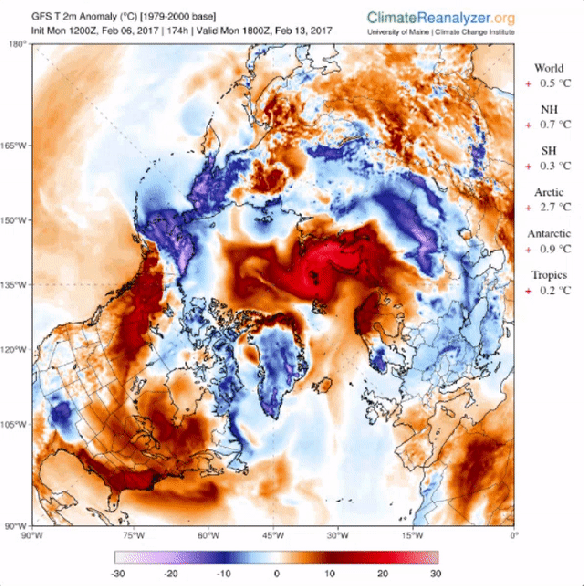GR: Climate change in action. We are losing the polar ice cap and that is changing Earth’s climate right now. Nothing good will come of it.
“Weird. Strange. Extreme. Unprecedented. These are some of the words that describe what’s been happening in the Arctic over the past year as surge after surge of warm air have stalled, and at times reversed, sea ice pack growth. And the unfortunate string of superlatives is set to continue this week.
The animation shows projected polar temperature anomalies through Feb. 13, 2017.

Right now, “A massive storm is swirling toward Europe. It’s a weather maker in itself, churning up waves as high as 46 feet and pressure dropping as low as is typical for a Category 4 hurricane as of Monday. The storm is to the southeast of Greenland and its massive comma shape has made for stunning satellite imagery. The storm is expected to weaken as it approaches Europe, but it will conspire with a high pressure system over the continent to send a stream of warm air into the Arctic through the Greenland Sea.
“Temperatures are forecast to reach the melting point in Svalbard, Norway, an island between the Greenland and Karas Seas. The North Pole could also approach the melting point on Thursday.
“It’s just the latest signal that the Arctic is in the middle of a profound change. Sea ice extent has dropped precipitously as has the amount of old ice, which is less prone to breakup. Beyond sea ice, Greenland’s ice sheet is also melting away and pushing sea levels higher, large fires are much more common and intense in boreal forests and other ecosystem changes are causing the earth to hyperventilate.
“Together, these all indicate that the Arctic is in crisis. It’s the most dramatic example of how carbon pollution is reshaping the planet and scientists are racing to understand what comes next.” –Brian Kahn (More: The Winter of Blazing Discontent Continues in the Arctic | Climate Central.)

